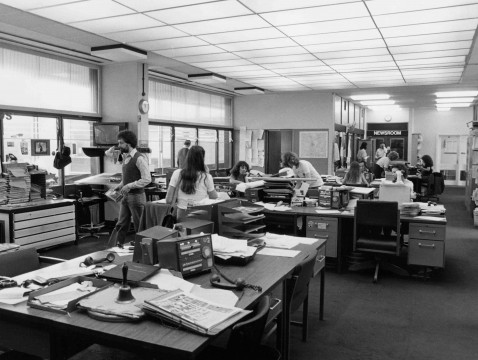During my time in the newsroom all material – except for a few ‘features’ was shot on reversal commag stock. The main problem with commag stock was, of course, the separation of the gate and the recording head, meaning that cutting the picture in the right place was wrong for the sound and vice-versa, hence the need to transfer the sound to sepmag stock (16mm magnetic tape, but it was perforated like 16mm.). If time didn’t allow for the transfer, then the cut mismatch had to be accommodated by either inserting a noddy (or the next actual reporter’s question preceeded by a pontifical (leading) noddy, or any one of a number of other technical fudges!). Or else it needed dubbing in studio 9 where we covered the bumps with suitable audio (commentary, SFX, music etc.) recorded onto sepmag stock in the TK machine, or occasionally dubbing it live if a last-minute network insert run live from London (more adrenaline than on a battle-field!). Not forgetting – as occasionally happened – to gently remind the TK operator to ‘pull it up 3 frames’ before TX.
I don’t believe edited sepmag was ever laid back to the commag – apart from anything else, the resultant audio would have ‘bumped’ over the edits. Why would you bother when the commag track was about a 10th the size of the sepmag? Having had the opportunity to see other regional news mags, and how they coped with commag and all its attendant problems (usually live reporter v/o in the studio + live grams) I think studio 9 was an elegant and efficient solution, no matter how much some of the ‘proper’ dubbing mixers looked down their collective noses at us! The features, and the opt-outs were usually shot on either reversal (with the commag track not used, or used as either a guide track or occasionally a wild track) with sound on 1/4″ recorded on a Nagra or mute colour neg + 1/4″. What a faffy world it was before video/u-matic/Beta/digibeta, but I count dubbing shifts in studio 9 as some of my happiest times in Pebble Mill.
Paul Freeman
Peter Poole, left the following comment on the Pebble Mill Facebook Group: ‘Hi Paul, thanks for an interesting blog. I probably complained about Studio 9. You had limited facilities and time pressure. And looking back on it I think you did a good job. I remember station assistants playing sound effects discs live in Studio B to cover mute film. Norwich still did live commentary even when U-matic tape was in use.’

Fantastic picture of the newsroom. Naturally I am not in the picture as I was probably in Studio 9 dubbing a film or recording a voice over for some rookie reporter.
Great days.
keith.haley@direction.co.uk
Very interesting Paul. Just for the record in my very early days in the 60s I worked at Southern TV and we actually DID dub the sound back onto the original edited commag and did it , not by sepmag (none available), but back into an actual Arriflex camera!!! When I joined BBC South, also before Sepmag we actually ran any commentary and music non sync and live from quarter inch reel to reel tape!
I bow to your wider experience, Pete: I should have prefaced it with, “in Pebble Mill…” Everywhere, it seems had a different solution to the problems.
Keith – you might well have been upstairs working on ‘See Hear’ or trying to realise some other wild flight of fancy of Roger C’s.
Although you’re right you could have been holed up in 9. You were a good dubbing mixer, so was I, and that was in no small part because you trained me!
Can’t deside if the woman in the foreground (back to camera) is Andrea Highfield, (PA to John Clarke at that time,) or Andrea Cooper, graphics person: she is certainly on duty when the photo was taken, that’s her handbag hanging on the corridor louvres by the graphics desk. Letraset and caption card ! what a different world ! Pat Murphy with hair, and me with a perm.
Hello Paul
Great memories of the late 70’s with you. Never forget you once told me “Don’t let the bastards grind you down” … and they never did! ATB